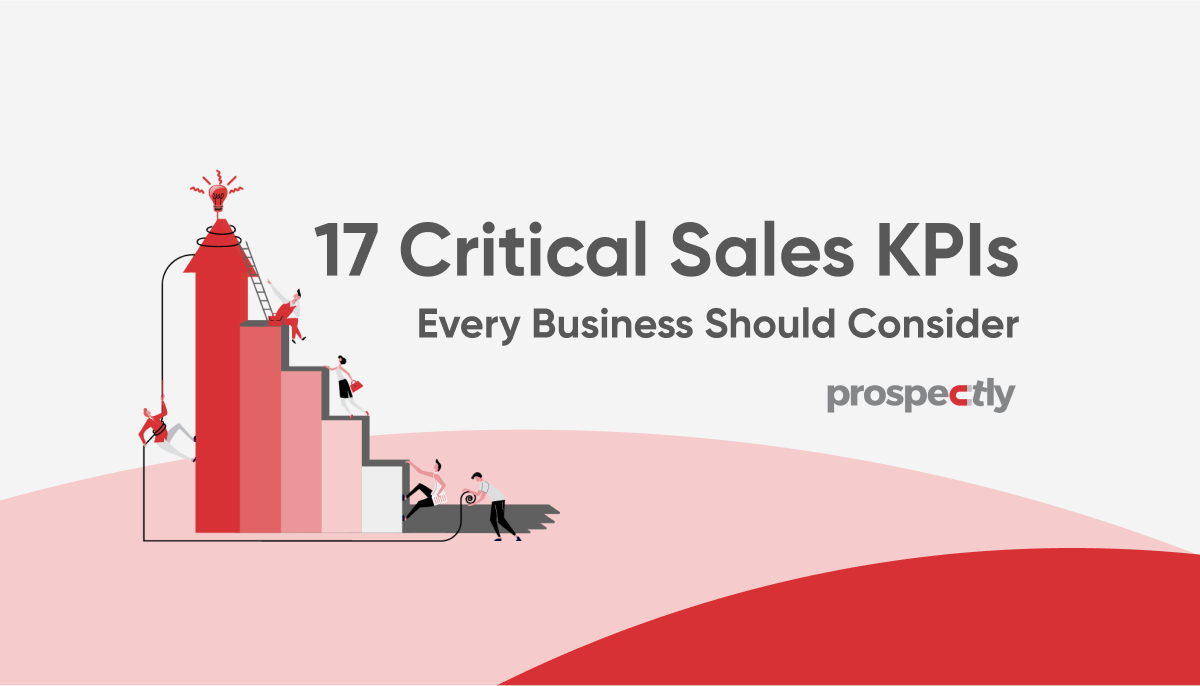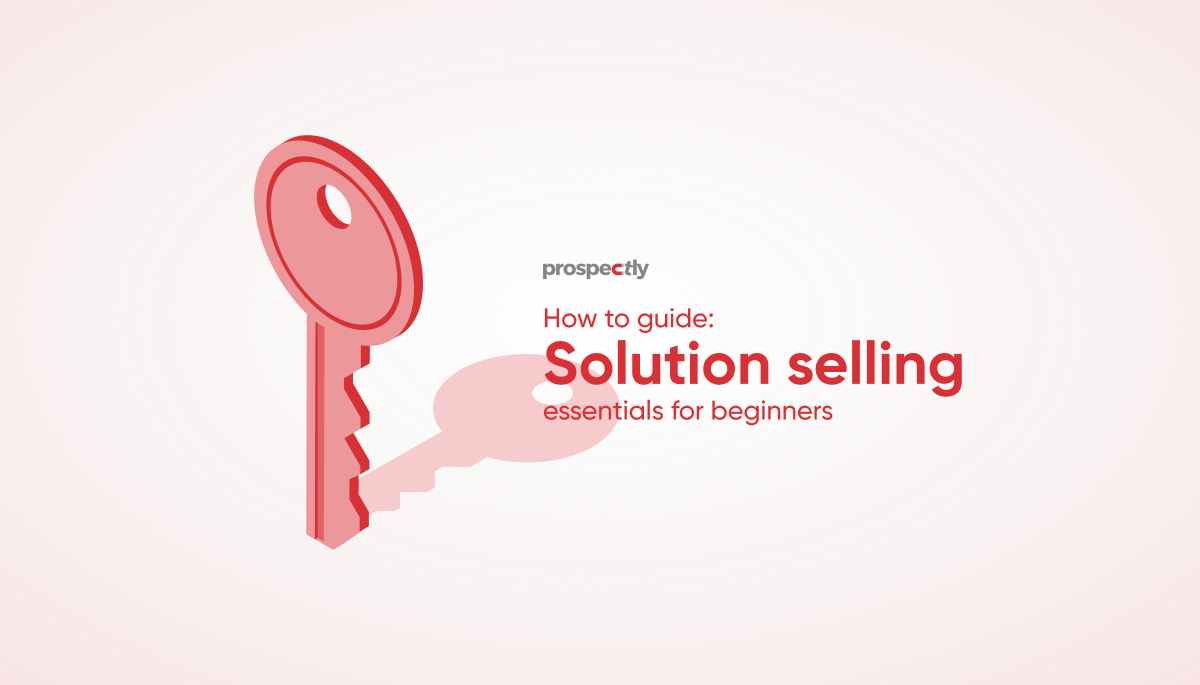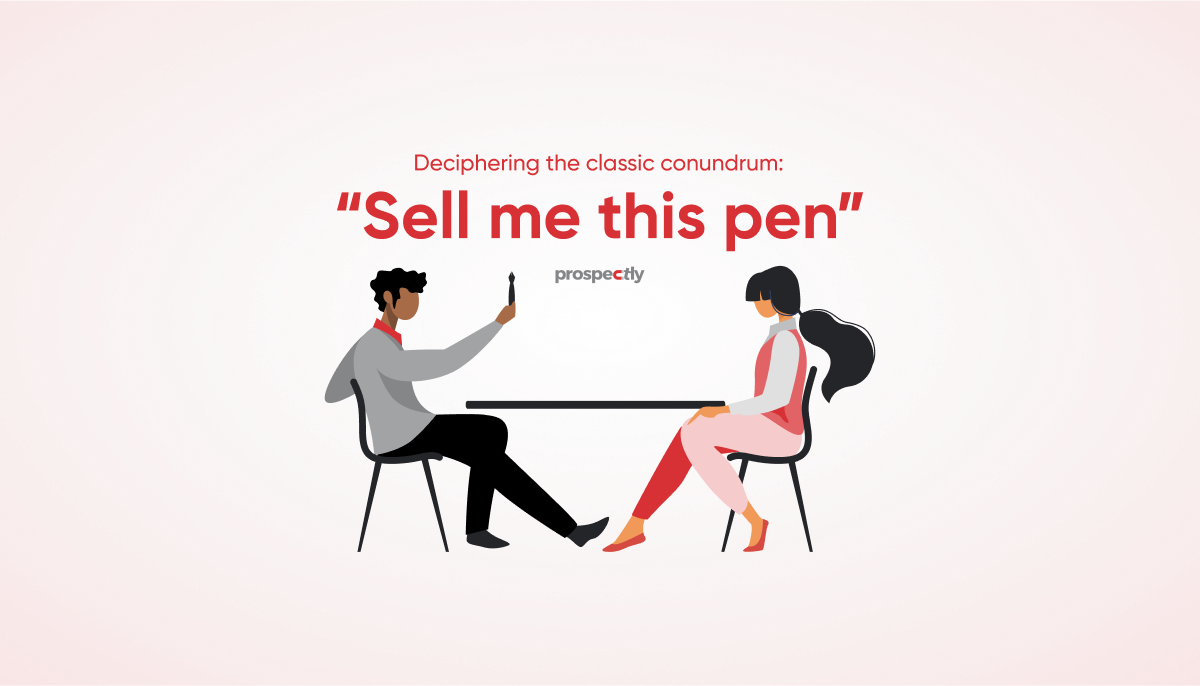22 Most daunting sales objections and how to overcome them
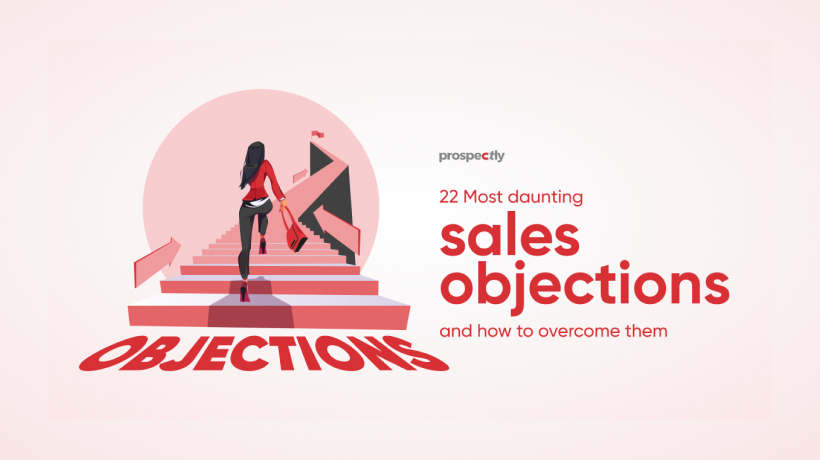
A sales objection is the most innate yet dreaded part of the sales process. It is also why your prospect chooses your competitor over you. So instead of giving in to your tendency to dodge grievances, it is crucial to hone your objection handling skills. This article will highlight the principal sales objections and practical strategies to address them.
Sales objection categories
Before you browse the list of most common objections, you need to identify the rationale behind each one. Categorizing sales objections based on these core reasons will enable you to draft tailored responses against each concern.
Need
Every great invention stemmed from a specific need. Is your target aware of your product/service? Do they know that you can meet their business needs? Your job is to make them aware of your existence and how you can make their life better.
Finances
The majority of businesses are built to make profits. So naturally, every prospect will be wary of taking financial risks. This is also the most common objection because your lead is either looking for a discount or using budgetary issues to conceal the actual cause. You can address this objection provided you uncover their motive.
Competition
It makes sense to go after a company that uses your competition. This proves that it needs your product. Prepare a comparative analysis to demonstrate how your product is better than what they currently use.
Timing
If you are an experienced or well-researched sales professional, you may be aware of your target market’s buying timelines. When your client suggests that you follow up at a later date, try to ascertain the reason. This will help you identify if you should include them in your follow-ups.
Trust
It takes excellent persistence to keep a prospect engaged during a cold call. It is an even bigger challenge to convince someone to trust you and your company. For a lead to be willing to confide in you, you will need to demonstrate natural confidence in yourself and your offerings. Mastering the perfect cold calling script will help you build conviction.
Resistance to change
Human brains crave familiarity and are wired to resist change. As long as their needs are met, your prospect will be unwilling to enter unfamiliar territory. Ironically, humans are also the most adaptable species. Overcoming this objection will depend on your ability to convince your prospect that the benefit of trusting you is worth the risk.
Deciding authority
Have you had a sales call where you spent a lot of time in product demos and answering questions only to discover that your contact is not the deciding authority? This might require you to repeat the whole process all over again for the key decision-maker. The ideal way to face this challenge is to research your prospect before making initial contact.
Unpleasant response
Of all objections, this is probably the most daunting and the reason behind your cold-calling anxiety. Picking up the phone to talk to a stranger takes immense courage. When a prospect is rude or disrespects you, it’s easy to get discouraged. Remember that such behavior is mostly a reflection of how he/she was feeling at that moment and not your fault.
Strategies to overcome sales objections
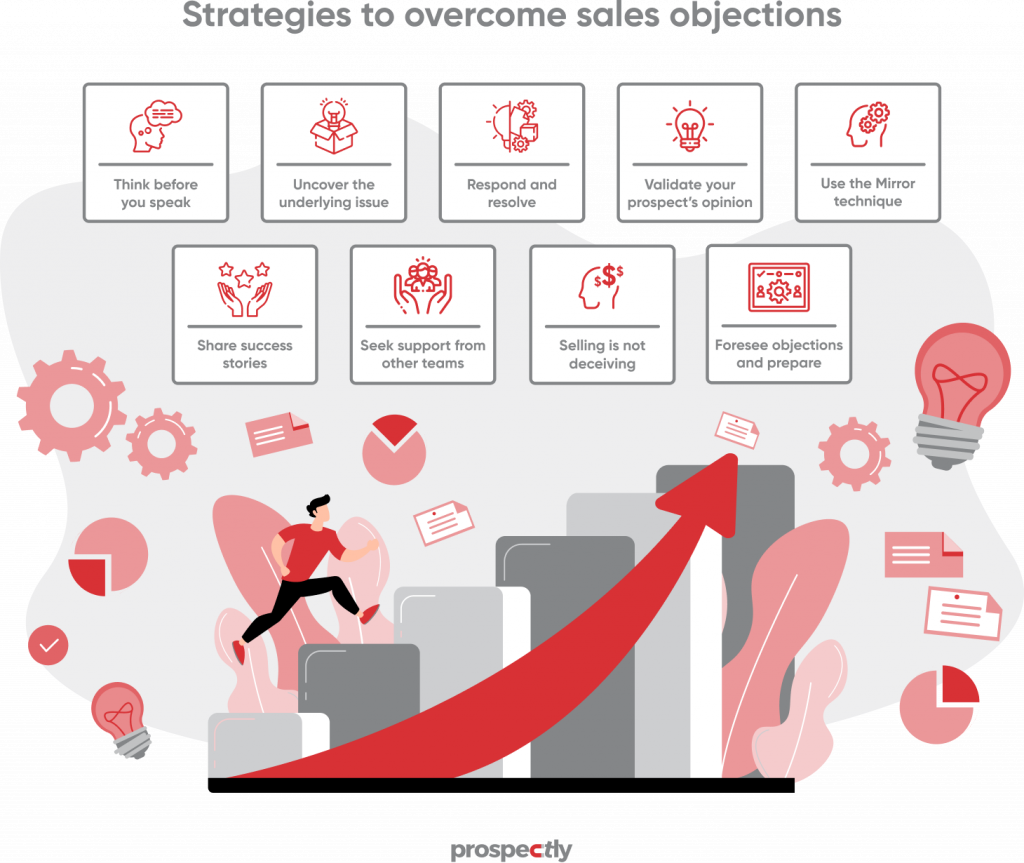
Objection handling requires you to possess product/service knowledge (your own along with your competitor’s) and the ability to think on your feet. More importantly, you will need a few tried and tested mechanisms to sail through such hindrances. Whether you are a seasoned sales professional or starting fresh, the following techniques can help you hone/cultivate your skills in addressing sales objections.
Think before you speak
When you face an objection, it might be tempting to react instantly to secure the sale. However, the data proves otherwise. The revenue intelligence platform Gong conducted a study that recommends the following steps when handling sales objections.
- If a prospect voices a concern, pause before speaking. When faced with objections, successful reps paused 5x longer than their counterparts.
- Instead of defending your position by speaking incessantly, give your target a chance to speak. High-ranking sales reps talk fairly less compared to their counterparts during client negotiations.
- The study also concluded that to assert authority, top reps slowed down their rate of speech to 176 wpm against 188 wpm maintained by their colleagues.
Uncover the underlying issue
Rather than giving in to your defensive tendencies to salvage the sale, make an attempt to understand the actual reason. Do not hesitate to use counter questions to get to the heart of the objections. You can use some of the following probing questions.
- Why do you think that is?
- Tell me how I can make this worth your time and investment?
- Can we offer any specific value add that might change your mind?
- Why do you think our product is expensive?
- Explain to me what exactly you are looking for.
In her book ‘Becoming Bulletproof’, former secret service agent Evy Poumpouras recommends framing questions using the T.E.D strategy (Tell me, explain, describe). When you start your questions with these words, it allows people to tell their stories and disclose what’s important to them.
Respond and resolve
Once you get to the core of the objections, respond to their concerns in order of priority. Your product knowledge will come in handy at this stage. When required, request some time to get back to them, but do that sooner than later. Do not leave the conversation without informing them of the ensuing steps and a timeline for your response.
Validate your prospect’s opinion
Let them know that you value their feedback by acknowledging that their concern is important and valid. This will humanize your conversation contrary to a typical sales conversation. You can use the below script.
“You know what, you are actually right, Karen. Thank you for bringing this up. [Insert your next steps].”
Use the Mirror technique
FBI veteran, CEO of The Black Swan Group, and the author of Never Split the Difference, Chriss Voss speaks about employing the Mirroring technique to address business communication issues. According to this practice, you paraphrase your target’s last few words. Observe the below conversations.
Client: “I am swamped. This is not the right time.”
Sales rep: “You don’t think this is the right time?”
Client: “Your prices are quite high. My boss will not approve.”
Sales rep: “Your boss will not approve?”
Repeating/mirroring your prospect with an upward tone helps them feel understood and heard. It creates an unconscious response for them to go on and enables you to gauge how firm their position is.
Share success stories
When your prospect demonstrates a particular concern, share an example of how you helped someone else with the same objection, or from a similar background. As it is often challenging to recall such examples instantly, prepare in advance. Before meeting the client, check if you/your company has served their peers or competitors and be ready with your story.
Seek support from other teams
The adage ‘It takes a village’ holds true while addressing sales objections. To handle every objection seamlessly, you will need the support of multiple departments within the company.
- Product team- to help educate the customer’s queries or concerns about usability.
- Support team – to share case studies from repeat clients.
- Marketing team – create promotional and objection handling FAQ docs.
- Management – participate in engaging with high-value accounts to build credibility.
Selling is not deceiving
Remember that selling does not equal deceiving. Even if you can push a product that does not serve your client, you will lose any chance of repeat business and risk tainting your brand image. If the objection seems valid to you, use it as a qualifier to clean up your pipeline and identify your ‘not-so-ideal’ customer profile. Accept that you can’t win them all.
Foresee objections and prepare
Before you get on a call or client meeting, make a list of all the possible objections they might have by matching your solution to their possible business need. Then ask yourself how you would address those questions. This way, instead of being caught off guard, you can sound and be confident for objection handling.
Common sales objections and response scripts
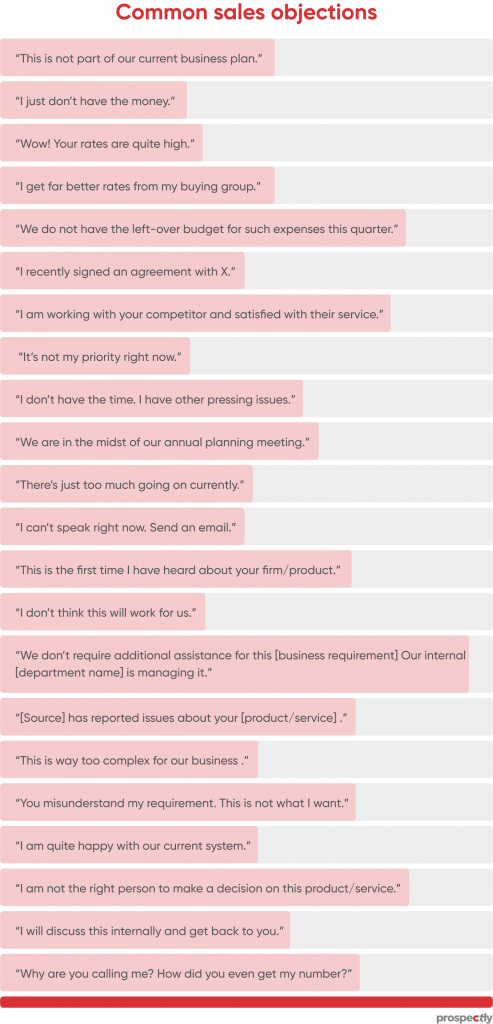
Below are some of the most common sales objections along with customizable response scripts. Most rebuttals may not guarantee an immediate sale. But they will open the window to further follow-ups and strengthen your relationship with your client.
Objection 1
“This is not part of our current business plan.”
Response script
“Are there any other pain points you are looking to address right now? Maybe I can help.”
Objection 2
“I just don’t have the money.”
Response script
“Allow me to demonstrate how our customized [offering] addresses your [business requirement] and is more suitable to your budget.”
Objection 3
“Wow! Your rates are quite high.”
Response script
“Explain to me why you feel this way?”
“How can we improve our service, so you find it worth this investment?”
Objection 4
“I get far better rates from my buying group.”
Response script
“What is the best price they offer?”
“Do you have any restrictions on purchasing from service providers beyond your group?”
Objection 5
“We do not have the left-over budget for such expenses this quarter.”
Response script
“Can I pencil in a meeting for next quarter to revisit your budget allocations?”
Objection 6
“I recently signed an agreement with X.”
Response script
“ How do you like their [offering]?”
“ Do you find any scope of improvement in their service? (If Yes) Maybe we can help you bridge that gap with our customized plans.”
Objection 7
“I am working with your competitor and satisfied with their service.”
Response script
“That’s good to know. Can you describe the best component of their product/service? It would be great for us to learn and improve.”
Objection 8
“It’s not my priority right now.”
Response script
“I understand. Could you spare a minute to state your current business priorities?”
Objection 9
“I don’t have the time. I have other pressing issues.”
Response script
“I completely understand your position. I will not take more than a few minutes.”
Objection 10
“We are in the midst of our annual planning meeting.”
Response script
“That’s great. Would you have the bandwidth to discuss our [your offerings] at the meeting? I will follow up with you once your calendar opens up again.”
Objection 11
“There’s just too much going on currently.”
Response script
“Please suggest a better time to revisit our discussion”
Objection 12
“I can’t speak right now. Send an email.”
Response script
“I understand. Could you quickly tell me what aspect of [your product/service] you be interested to know more about?”
Objection 13
“This is the first time I have heard about your firm/product.”
Response script
“We are [introduce your product/service and USP]. Even though we are new to the space, we do have quite a few happy customers like [insert company name].”
Objection 14
“I don’t think this will work for us.”
Response script
“I am sorry you feel this way. However, would you like to give it a try and utilize our free trial period?.”
Objection 15
“We don’t require additional assistance for this [business requirement] Our internal [department name] is managing it.”
Response script
“That’s great to hear! What are your current goals in this area?”
“How would you rate your progress compared to the end goal?”
Objection 16
“[Source] has reported issues about your [product/service] .”
Response script
“I appreciate your feedback and will let the concerned team know. Can I share what [name your happy client] have to say about our [product/service] ?”
Objection 17
“This is way too complex for our business .”
Response script
“Please describe the features that appear confusing to you. I will schedule an additional demo to clarify those.”
“ We also have an excellent customer support team for any post-sales queries that you may have.”
Objection 18
“You misunderstand my requirement. This is not what I want.”
Response script
“I am sorry, I thought you need ____ but l understand it’s not so. Could you spare a few more minutes to explain your pain points?”
Objection 19
“I am quite happy with our current system.”
Response script
“Sounds wonderful! How are you addressing your [state a key issue you can solve] needs?”
Objection 20
“I am not the right person to make a decision on this product/service.”
Response script
“Could you introduce me to your co-worker/peer/boss with the decision-making authority? Your referral would mean a lot to us.”
Objection 21
“I will discuss this internally and get back to you.”
Response script
“I would be happy to offer another demo/presentation to your team that is involved in this decision. Can we schedule a time for the same?.”
Objection 22
“Why are you calling me? How did you even get my number?”
Response script
“I am sorry if I reached you at a bad time. I was just going through your website and wondered about [quickly check on their requirement]. Is it okay if I schedule a call when you have some free time?”
Sales objection does not imply rejection

To sum up, when you face an objection, consider it an opportunity to explore your customer’s underlying needs. Use counter questions to understand their perspective. Finally, keep calm and be proactive in anticipating objections before you speak to a client. This approach will minimize surprises in overcoming sales objections.
